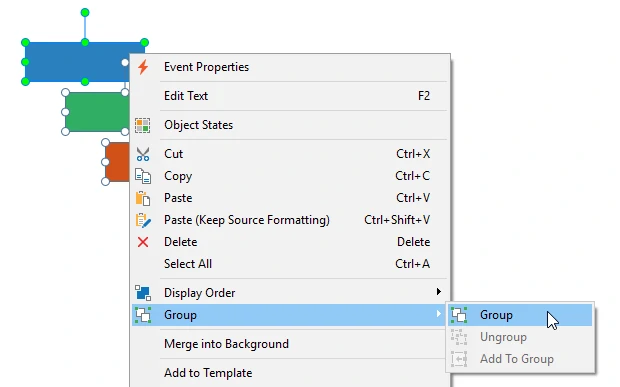Object grouping is a handy new feature ActivePresenter 7 offers you. It allows you to work with multiple objects as if they were a single object. In this tutorial, we’ll show you how to group objects and work with groups.
Grouping Objects
Object grouping lets you move, rotate, or resize multiple objects at the same time as if they were a single object. For example, you want to move several objects without changing their relative distance to each other. To do that, you have to select all of them, then drag the mouse, and do the same things each time you want to move them. Now with object grouping, things get much easier. Just group all the objects you want, select the group, and move it.
Do the following to group objects:
Step 1: Hold down CTRL while selecting all the objects that you want to include in a group.
Step 2: Right-click the objects > Group > Group. Alternatively, click the Format tab > Group > Group or the Home tab > Arrange > Group.

The selected objects are grouped. A single box with resizing handles appears around the entire group.

At the same time, in the Timeline pane, all the child objects’ time bars are merged into the only time bar of the group. The Selection pane lists all the child objects under and at the next indent level compared to their group. Click the +/- button to expand or collapse these child objects.
Step 3: Rename the group to easily find and work with it. Click the Properties pane > Interactivity > General or go to the Selection pane.
Note:
- Another way to select multiple objects is dragging the mouse across them. In other words, use a rubber-band selector. Click on a slide and drag the mouse, a rubber-band selector appears. All the objects that stay in or intersect with the selector will be selected.
- If you’ve already selected several objects and want to select more, hold down CTRL and click them. If you include some objects you don’t want, hold down CTRL and click redundant objects to deselect them.
- After you make a group, you can still work with child objects in that group. Select the group, and then click an object to select it.
- A group and its child objects are mutually exclusive when it comes to converting objects into drag sources/drop targets. That is, you can only convert either a group or its child objects into drag sources/drop targets.
- Some features are not available to child objects, namely Attached audio, Show to the end of slide, Show In Mode, and Pause presentation to wait for user input.
Adding Objects to a Group
ActivePresenter lets you add objects to an existing group. Do the following:
Step 1: Select a group and one or more objects that you want to add to the group.
Step 2: Right-click them > Group > Add to Group. Alternatively, click the Format tab > Group > Add to Group or the Home tab > Arrange > Add to Group.
Nesting a Group in Another Group
Nested groups are available in ActivePresenter 7. You can nest groups within groups. Simply put, groups can contain groups as members. To nest a group in another group, use the same techniques for grouping objects. Just select all the objects/groups you want, right-click > Group > Group. A new group is created containing all the selected objects/groups as members.
Ungrouping Objects
Sometimes, you no longer need a group. You want to break it apart so that you can more easily select and format each individual objects. To ungroup a group, first select the group. Then, right-click it > Group > Ungroup. Alternatively, click the Format tab > Group > Ungroup or the Home tab > Arrange > Ungroup.
Changing Group Layout
ActivePresenter supports grid layout for groups. This feature places child objects of a group in a grid pattern, which is useful when you want to draw tables to display fields in a grid layout or when you want to align child objects in a group.
To change the group layout to grid, select the group and do the following:
Step 1: Click the Properties pane > Size & Properties > Group Layout.
Step 2: Click the Mode combo box and select Grid. The grid layout ignores the original size of all objects in a group. Instead, it assigns a fixed size to all of them.
The grid size is defined by the number of columns, horizontal spacing between columns, and vertical spacing between rows. Change the values for these parameters if needed. The number of rows will be automatically counted based on the number of child objects and columns.
For further modification, click Advanced Settings…. A dialog appears allowing you to define the width ratio between columns or the height ratio between rows. If the value is 0, the minimum size of objects will be used.
For example, the group below has two columns (width ratio 1:2) and two rows (height ratio 1:3). As you can see, the width of the blue box is one-half of the green one. Meanwhile, the height of the blue box is one-third of the orange one.
That’s it! You’ve learned all about object grouping in ActivePresenter 7. Remember to group objects whenever necessary to streamline your editing and speed up your workflow.





